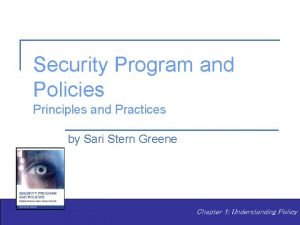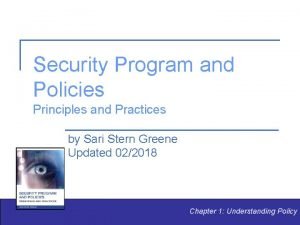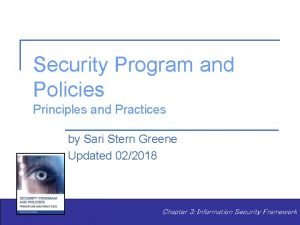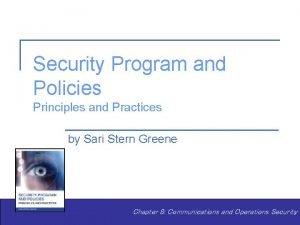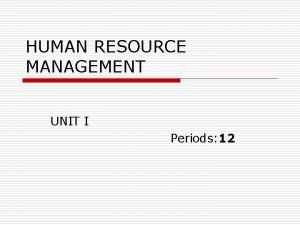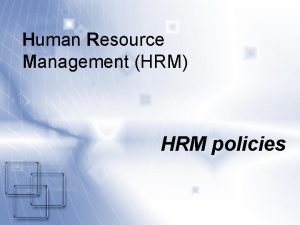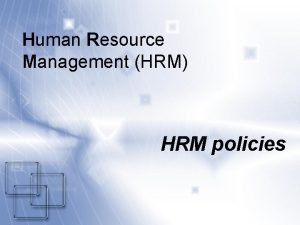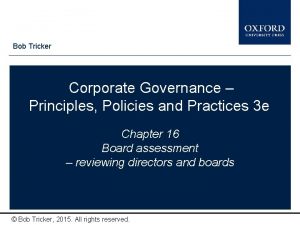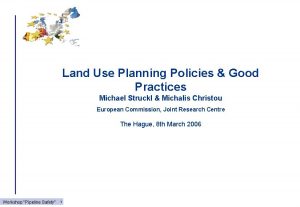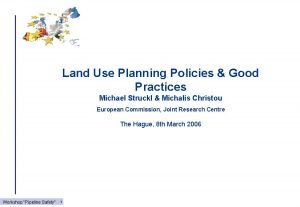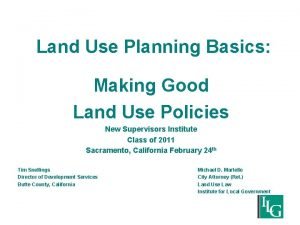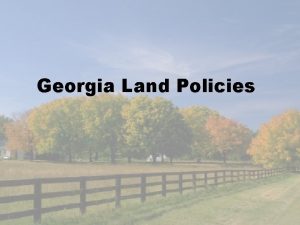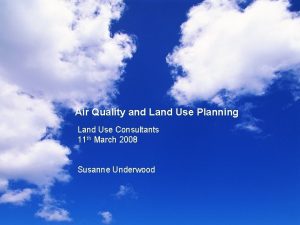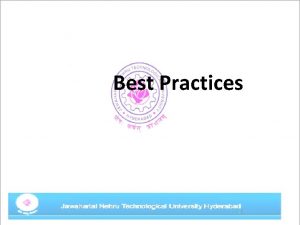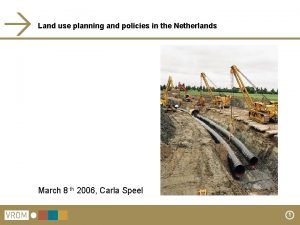Land Use Planning Policies Good Practices Michael Struckl




















- Slides: 20

Land Use Planning Policies & Good Practices Michael Struckl & Michalis Christou European Commission, Joint Research Centre The Hague, 8 th March 2006 Workshop "Pipeline Safety" 1

Aim and Scope of the Seveso II Directive Article 1: Aim This Directive is aimed at the prevention of major accidents which involve dangerous substances, and the limitation of their consequences for man and the environment, with a view to ensuring high levels of protection throughout the Community in a consistent and effective manner. Article 2 : Scope “The Directive shall apply to establishments where dangerous substances are present in quantities equal to or in excess of the quantities listed in Annex I (of the Directive)” ………… Article 4: Exclusions This Directive shall not apply to the following: ……… (d) the transport of dangerous substances in pipelines, including pumping stations, outside establishments covered by this Directive; Workshop "Pipeline Safety" 2

Land-use planning (Seveso II Directive - Art. 12) Ø Ø Past accidents (Bhopal, Mexico City) demonstrated that the consequences can be aggravated if dangerous sites and dwellings are close together Art. 12 requires that q LUP policy shall take account of major accident hazards (prevention/mitigation) through controls on § siting of new establishments § modifications of existing sites § new developments (residential areas, major transport routes, locations frequented by the public, environmental sensitive areas) q Establish and maintain Appropriate Distances or Additional Technical Measures Workshop "Pipeline Safety" 3

Appropriate distance is……………. „Appropriate distance“ means: Take into consideration the existence of a major hazard site and establish a „zoning“, which is a restricted use of land around the site proportional to the risk posed by the site (► no „ totally free zone“ of separation) Workshop "Pipeline Safety" 4

Land Use Planning became relevant because of…. …. shrinking distances of industrial sites to agglomerations of the population Workshop "Pipeline Safety" 5

Land Use Planning became relevant because of…. …the question of compatibility of situations Workshop "Pipeline Safety" 6

Land Use Planning became relevant because of…. …. recent accidents (Enschede, Toulouse) Workshop "Pipeline Safety" 7

The LUP problem is not uniform across the EU Workshop "Pipeline Safety" 8

Consequences of approach divergence and recent accidents • Spring 2002: EU-seminar in Lille proposes the re-establishment of the European Working Group on Land Use Planning (EWGLUP) • Autumn 2002: Kick-off for the Working Group • 2003: Negotiations for the amendment of the Seveso II – Directive, EP demands enhanced legislation for Land Use Planning • End of 2003: Directive 2003/105/EC comes into force and amends Article 12 of Seveso II • Mandate in Directive 2003/105/EC to establish a database for risk data and develop guidance documents • 2003 – 2005 ongoing activities of the EWGLUP • End of 2006: deadline for the products required by the Amendment Directive Workshop "Pipeline Safety" 9

Results of the EWGLUP – work so far • Definition of „Good Practice“ of risk assessment in Land Use Planning with particular respect to the Seveso II • Clarifications on legal requirements in the Directive • Identification of common elements in the various approaches • Different understanding about the role of Land Use Planning in the context of prevention of MA and mitigation of the consequences ► attempts to define a „common language“ • Recommendations for „roadmaps“ on how to comply with the legal requirement in a consistent manner • Attempts to develop a database for risk data and accident scenarios Workshop "Pipeline Safety" 10

Principles of „Good Land Use Planning Practice“ • The LUP policy should be consistent: consistent Outcomes from broadly similar situations are broadly the same under similar conditions Ø Hazard/Risk Assessment method should exist Ø Most important input: representative set of scenarios • The LUP policy should be reasonable and the constraints should be proportional to the level of risk Ø Criteria should exist for unacceptable risk/harm Ø Development types are characterised • The LUP policy should be transparent: transparent Clear understanding of the decision-making process Ø Understandable and clear system with responsibilities of key actors described Ø Mechanisms for independent internal control exist Workshop "Pipeline Safety" 11

Some important clarifications of the legal requirements • The requirements of Article 12 need not have an effect immediately but over time (5 – 10 years) • The risk caused by an „undesirable situation“ must exceed a level of significance ►Member States need to define that level (could be a numerical risk value, could be an effect value, could be a qualitative description) • Equity balance between operators and communities should be achieved with respect to constraints • Mitigation of major accident consequences through Land Use Planning can only be achieved in combination with emergency planning • Some developments should be allowed near to establishments covered by the Directive provided the risks are acceptable • Seek not to replace appropriate distances by additional measures in the case of new establishments Workshop "Pipeline Safety" 12

Commonly used approaches currently in Land-Use Planning decisions Ø Ø Ø “Risk-based” approach - assessment of both the consequences and the likelihood of occurrence for a number of (usually preselected, based on occurrence frequency estimation) accident scenarios and calculation of risk as a function of likelihood and consequences. Risk tolerability criteria (individual risk / societal risk). “Consequence-based” approach - assessment of consequences of the worst scenario within a set of (pre-selected) reference accident scenarios; occurrence frequencies implicitly taken into account as a limiting factor for definition of scenarios. “Generic” safety distances, for standardised installations, deriving from standard risk/hazard assessment (mostly derived from a consequence-based assessment) of a typical facility, mainly used as default or for screening purposes. Workshop "Pipeline Safety" 13

Other approaches Ø Deterministic approach with implicit judgment of risk = “State-of-the-Art” - target to operate without imposing any risk to the population outside the fence. Applies State-of-the-Art technology and take additional safety measures on the source in order to restrict the consequences within the fence, with strong role of the precautionary principle. Risk is taken implicitly into account in the definition of the “state-of-the-art”. Requires additional deterministic concept of reference scenarios for Land Use Planning purposes. Ø Semi – quantitative approaches (or “hybrid methods”): Imposed by new legislation with respect to Article 12 of Seveso II (e. g. in Italy); not much feedback so far about the practical performance Workshop "Pipeline Safety" 14

Common elements of the approaches used in support to Land-Use Planning decisions Ø Scenarios – Use either individually (seldom), pre-selected (most cases, deterministic selection) or implicitly for derivation of generic distances Ø Failure rates and event frequencies – Use either directly (in the risk assessment), indirectly as limiting condition for selection of scenarios or implicitly for determination of the “state-of-the-art” Ø Scenario evaluation and endpoint values – Probabilistic and consequence (effect) endpoint values; applied in quantitative calculations, the deterministic method and implicitly in generic safety distances. Ø Additional Technical Measures: measures that reduce the likelihood and/or mitigate the consequences of a major accident as effective as the establishing of safety distance Workshop "Pipeline Safety" 15

Recommended basic assumption: accident scenarios LUP-relevant scenarios: if a scenario has sufficient safety barriers and is extremely unlikely to happen and it provides sufficient time for emergency response measures to be activated, this scenario may not be considered as LUP-relevant Workshop "Pipeline Safety" 16

Database on risk scenarios and failure frequencies Ø Need to base the decisions on reliable data with regards to failure rates and event frequencies Ø The database shall be open on-line to the public ► problem of disclosing data Ø Available sources: sources Purple Book, TNO, FRED (UK), AMINAL (B) Ø Problems in data comparison: Ø Common sources of information – old data Ø Discrepancies can be significant Ø Often, different scope of studies: Frequencies referring to initiating events or to the top-event (without reference to the causes) Ø Underlying technological standard not known Ø Expert judgment still “irreplaceable tool” Workshop "Pipeline Safety" 17

Substance Generic Scenarios Data D/P Evaluation Qualitative/ Quantitative Installation Causes If incompatible … If compatible Frequencies Conditions Revised list of Scenarios For Re-Evaluation … Technical Measures (efficiency? ) Workshop "Pipeline Safety" 18

Open Problems • EU-wide agreement on certain conventions (conditions for selecting scenarios, State-of-the-Art for safety technology, efficiency of measures, endpoint values) • Failure frequency data (reliability, cooperation with industry, more recent data) • More coherence deterministic/probabilistic approach • Efficient cooperation between on-site plant safety, land use planning and external emergency response Workshop "Pipeline Safety" 19

More Information http: //landuseplanning. jrc. it Workshop "Pipeline Safety" 20
 Sdlc principles and practices
Sdlc principles and practices Security program and policies principles and practices
Security program and policies principles and practices Security program and policies principles and practices
Security program and policies principles and practices Security program and policies principles and practices
Security program and policies principles and practices Security program and policies principles and practices
Security program and policies principles and practices Fombrun model
Fombrun model Hrmhrm
Hrmhrm What are hr policies
What are hr policies Corporate governance principles policies and practices
Corporate governance principles policies and practices Land use planning '' lecture notes
Land use planning '' lecture notes Land economics lecture notes
Land economics lecture notes Land use planning '' lecture notes
Land use planning '' lecture notes Define land use planning
Define land use planning Good thoughts good deeds good words
Good thoughts good deeds good words Hi good morning video
Hi good morning video Good afternoon buenas tardes
Good afternoon buenas tardes You are good when there's nothing good in me
You are good when there's nothing good in me Cómo se dice buenas tardes
Cómo se dice buenas tardes Decs order no 11 s 1987
Decs order no 11 s 1987 What are landforms
What are landforms Identify the landform
Identify the landform

